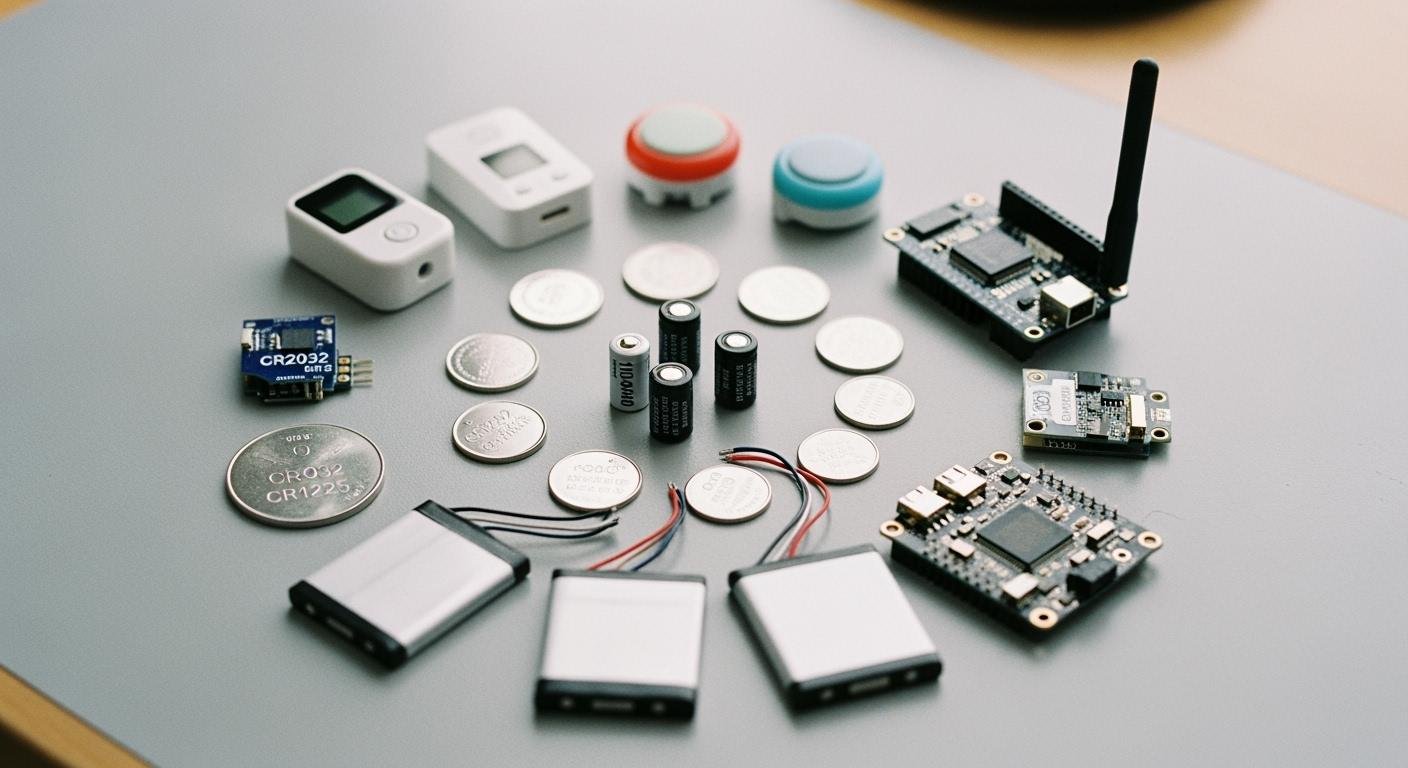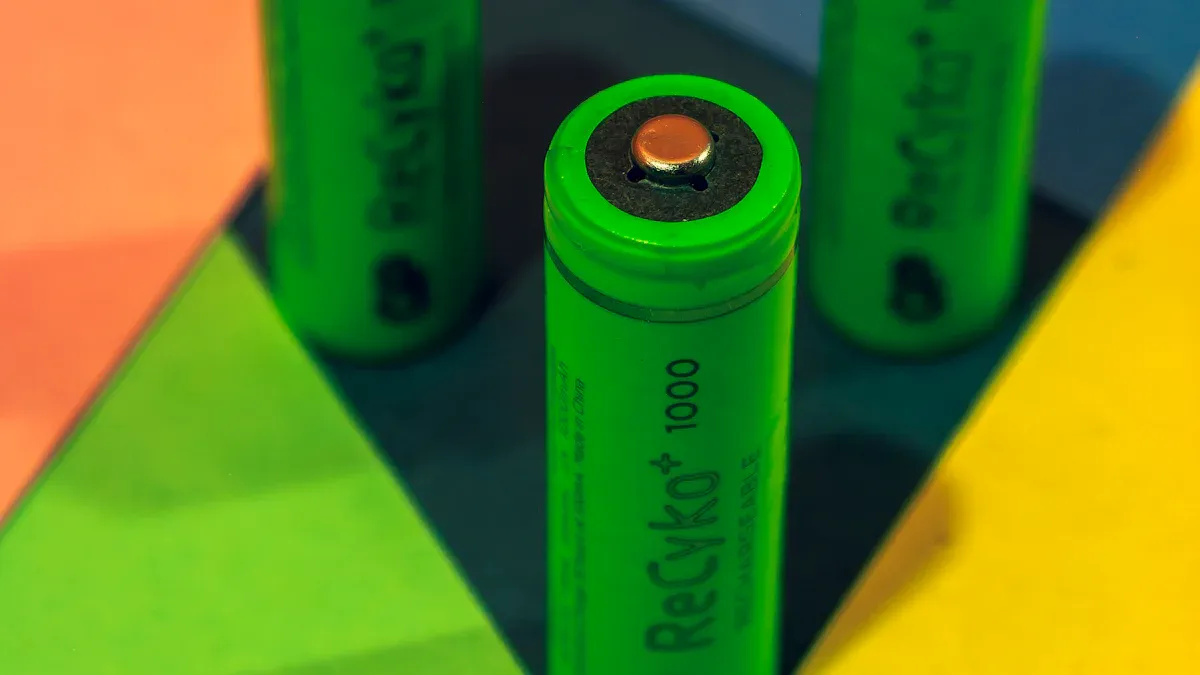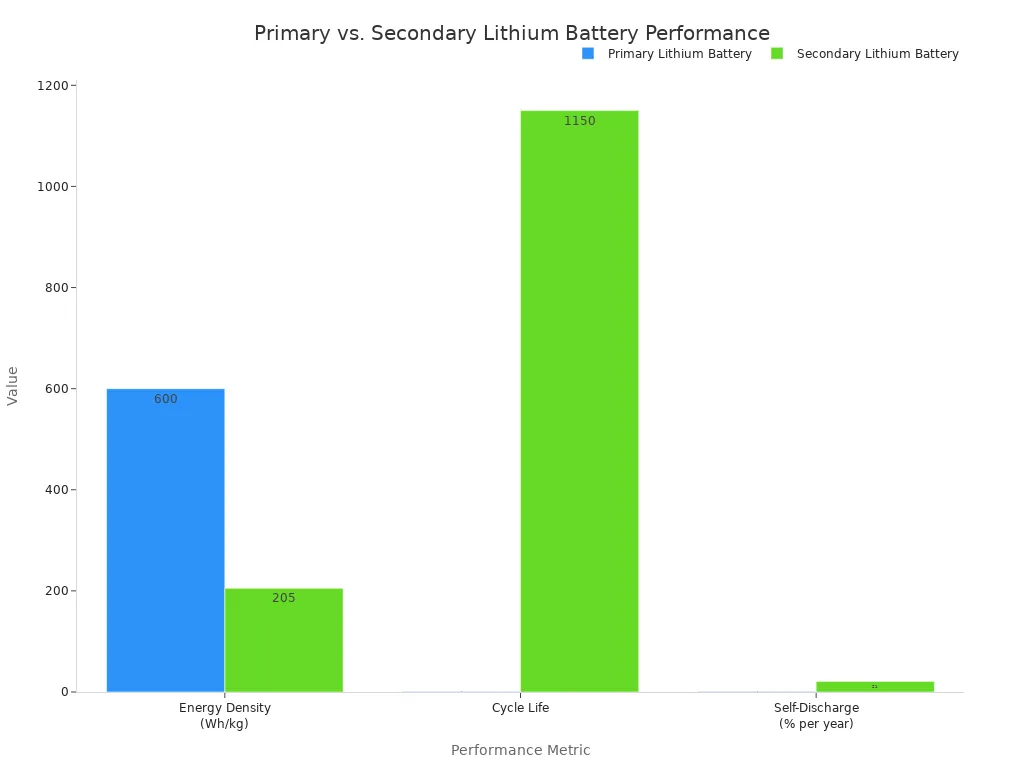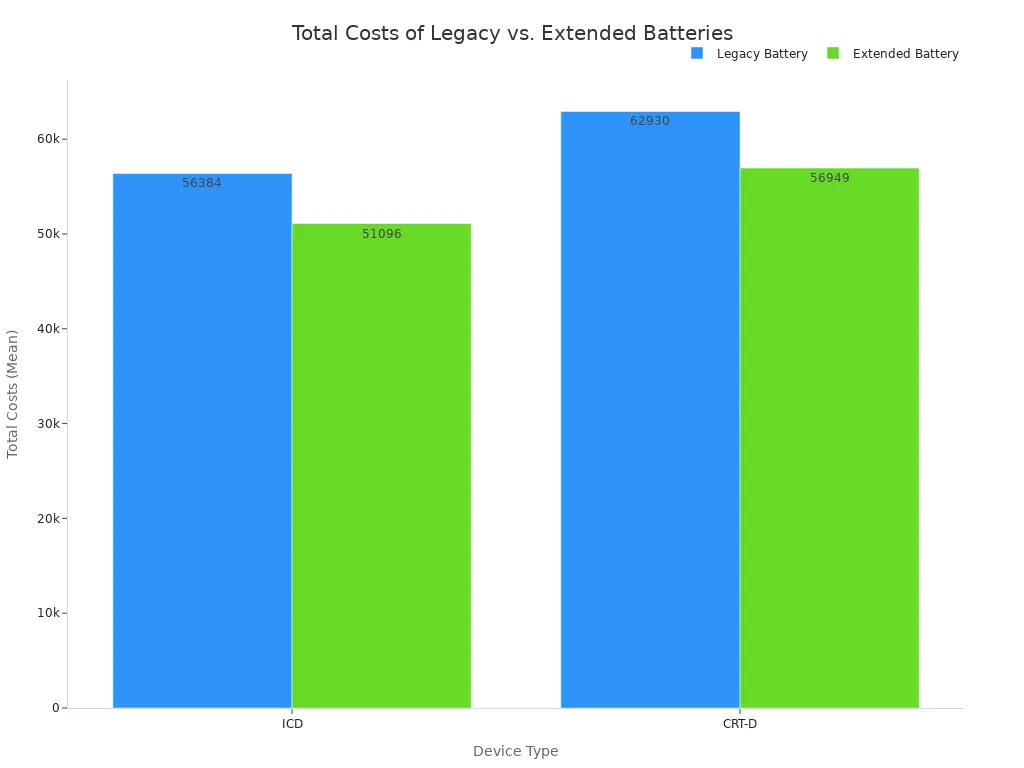
Choosing the right battery is critical for the success of your IoT project. The global IoT market is projected to grow at a Compound Annual Growth Rate of 18.8% to USD 153.2 billion by 2029. This growth makes choosing the right battery a vital task for your devices.
For most IoT devices, lithium batteries are the clear front-runner. The high energy density of lithium chemistry gives your battery a longer life. This makes lithium the go-to power source.
This guide helps you navigate the process of choosing the right battery by comparing primary and secondary lithium options.
Choosing a Lithium Battery for IoT Devices

You must decide between two main types of lithium batteries: primary (single-use) and secondary (rechargeable). Your choice depends entirely on how your IoT device will be used. Primary lithium batteries offer a very long-lasting power supply but can only be used once. Secondary lithium batteries can be recharged hundreds of times, making them great for frequently used devices.
This table gives you a quick look at the differences in battery performance.
| Aspekt | Primary Lithium Battery | Secondary Lithium Battery |
|---|---|---|
| Wiederaufladbarkeit | Non-rechargeable, single-use | Rechargeable, multi-use |
| Spannung | Typically 3.0V–3.6V | Typically 3.6V–3.7V |
| Die Energiedichte | Higher (~500–700 Wh/kg) | Lower (~150–260 Wh/kg) |
| Zyklus Leben | One-time use | 300–2000 cycles |
| Self-Discharge | Very low (<1% per year) | Higher (1.5–2% per month) |
| Kosten | Higher upfront cost, no reuse | Lower cost per use over time |

Let’s explore which battery type is right for your project.
Primary Lithium Battery: ‘Set and Forget’ IoT
You should choose a primary lithium battery when your IoT devices need to run for years without maintenance. These are perfect for “set and forget” applications where replacing or recharging a battery is difficult or impossible. Their key advantage is a very low self-discharge rate, often less than 1% per year. This means the battery holds its charge for a very long time.
Two popular primary lithium chemistries for IoT are:
- Lithium-Thionyl Chloride (Li-SOCl2): This is the top choice for longevity. A Li-SOCl2 battery can power low-drain devices for 10 to 20 years. Die stable chemistry prevents the battery from degrading quickly. This long-life expectancy makes it ideal for remote sensors, utility meters, and parking sensors that need reliable power over a long lifetime.
- Lithium-Manganese Dioxide (Li-MnO2): This battery is a more affordable option than Li-SOCl2. It offers high performance and is excellent for demanding applications that need strong pulses of power, like asset trackers that send location data periodically.
You would use these types of batteries for connected objects in remote locations or harsh environments where consistent, long-term power is the most important factor.
Secondary Lithium Battery: High-Use & Rechargeable
You should select a secondary lithium battery for high-use IoT devices that you can easily recharge. These batteries are the standard for consumer electronics because you can charge them again and again. This makes them cost-effective over their lifetime. Their ability to deliver strong, sustained power also makes them necessary for many modern IoT applications.
The most common secondary lithium batteries are:
- Lithium-ion (Li-ion): These are known for their good energy density and long cycle life. Li-ion batteries are designed for a longer lifetime, which adds to their value over time.
- Lithium-polymer (Li-poly): These offer more flexibility in shape and size, making them perfect for compact devices. A Li-poly battery typically provides 300 to 500 charge cycles. Some can even exceed 1,000 cycles. This is ideal for wearables, a smart device in your home, or other gadgets you use daily.
Safety First with Rechargeable Lithium Batteries! 💡 Rechargeable lithium batteries pack a lot of power. You must handle them correctly. Manufacturers follow strict safety standards like UL 2054 and UN 38.3 to prevent risks like overheating or fire. Always buy your battery from a trusted source. You should also use the correct charger and follow all handling instructions to ensure the safety and battery life of your devices.
This battery type is best for any smart device where power sources are available for recharging. The high power output supports complex functions, and the reusability lowers the total cost over the product’s battery life.
Comparing Your Battery Type Options

While lithium batteries are a top choice, you should also consider other types of batteries for specific needs. Exploring alternatives like NiMH or specialized lithium button cells helps you find the perfect match for your project’s budget and design.
The Case for Nickel-Metal Hydride (NiMH)
You might choose a Nickel-Metal Hydride (NiMH) battery when cost and safety are your main concerns. NiMH batteries are a dependable and cheap power source for many applications. They are a great fit for devices that need steady power and frequent recharging.
Consider using an NiMH battery for these reasons:
- Wider Temperature Range: They operate well in temperatures from -20°C to 60°C, making them suitable for outdoor devices.
- Enhanced Safety: NiMH chemistry has a lower risk of overheating compared to a lithium battery, which makes it a reliable choice for harsh environments.
- Lower Cost and Environmental Impact: These are often more affordable upfront and contain fewer toxic materials, making them easier to recycle.
An NiMH battery is less powerful than a lithium one and has a higher self-discharge rate. However, its durability and safety make it a strong contender for certain industrial or backup equipment.
When to Use Lithium Button Batteries
You should use lithium button batteries when your IoT devices are very small. The growth of wearable technology like smartwatches and fitness trackers has made these compact batteries very popular. Their small, lightweight design is essential for these portable gadgets.
A common example is the CR2032 battery. The name tells you about its features: ‘C’ means it has lithium chemistry, ‘R’ means it is round, ’20’ is its 20mm diameter, and ’32’ is its 3.2mm height. This popular battery provides a nominal voltage of 3 Volts. You will find these button cells in a wide range of small electronic devices, from medical sensors to home automation remote controls.
Key Factors to Finalize Your Selection
You have narrowed down your options. Now you must analyze a few key factors to make your final battery choice. Choosing the right battery requires a close look at your device’s specific needs. A careful evaluation of power consumption, environment, lifespan, and cost will guide you to the best solution for your IoT applications.
Power Consumption Profile
You need to understand how your device uses energy. This is its power consumption profile. The consumption changes depending on whether the device is active (sending data) or in sleep mode. Accurately measuring this consumption is the first step in choosing the right battery.
You can measure power consumption using several methods:
- Active Mode: You can use specialized meters or tools that show electrical signals to measure the current when the device is transmitting or receiving data.
- Sleep Mode: Measuring the very low current in sleep mode is challenging. You should use a high-precision digital multimeter (DMM) that can accurately capture tiny amounts of energy consumption.
- Dynamic Changes: IoT devices switch between modes quickly. Your measurement tool must be fast enough to capture these rapid changes to get a true picture of the total consumption.
Your device’s communication method also heavily impacts power consumption. Different wireless protocols have very different energy needs.
| Communication Protocol | Power Characteristics | Auswirkungen auf die Lebensdauer der Batterie |
|---|---|---|
| LPWAN (NB-IoT, LoRa) | Ultra-low power, intermittent communication | Devices stay in sleep mode, leading to long battery life. |
| LAN (Wi-Fi, Bluetooth) | High power consumption, high data rate | Frequent data transmissions shorten battery lifespan. |
| PAN (BLE, Zigbee) | Low power, short-range, periodic wake-up | Long standby times allow small batteries to last for years. |
| Cellular (3G/4G/5G) | High speed, wide bandwidth | High power use, especially when switching networks. |
Protocols like LoRa and NB-IoT are designed for low power consumption. They use features like Power Saving Mode (PSM) and extended discontinuous reception (eDRX) to keep the device in a deep sleep state for as long as possible. This dramatically reduces overall energy consumption and extends battery life for many IoT applications.
Operating Environment and Temperature
You must consider where your IoT devices will operate. The environment plays a huge role in battery performance and safety. Extreme heat or cold can drain your battery, reduce its capacity, and shorten its lifetime.
- Consumer-grade Li-ion batteries work best in a moderate range, typically from 0°C to 40°C.
- Industrial-grade batteries, like certain Li-SOCl2 or TLI Series Li-ion cells, are built for harsh conditions. They can operate in an expanded temperature range of -40°C to 85°C.
Humidity and corrosive elements are also major threats, especially for outdoor applications. Moisture can cause short circuits, corrosion, and electrolyte leakage. This damage reduces the battery’s reliability and can create safety hazards.
Protect Your Battery! 🛡️ You should use sealed enclosures to protect your battery from moisture, dust, and chemicals. Experts recommend keeping the humidity level inside the enclosure between 40% and 60% to prevent corrosion and maximize the battery’s lifespan.
Required Lifespan and Maintenance
You need to decide how long your device must operate before its battery needs service. For remote or hard-to-reach devices, a long-lasting power supply is essential. Choosing the right battery from the start minimizes future maintenance.
You can estimate the battery life with a simple calculation. First, you determine the average current consumption based on how much time the device spends in different modes.
- Calculate Average Current: Add the consumption in each mode (active, sleep, deep sleep).
- Estimate Lifespan: Use this formula to find the approximate lifetime.
Battery Life (in hours) = Battery Capacity (mAh) / Average Current Consumption (mA)
Another key factor is the battery’s self-discharge rate. This is the energy a battery loses while sitting idle. Primary batteries are far superior in this area. A primary lithium battery might lose only 10% of its charge in 5 years. In contrast, a secondary lithium-ion battery can lose 1-3% of its charge every month. This makes primary batteries the clear winner for longevity in low-power applications.
Total Cost of Ownership
Choosing the right battery is not just about the initial price. You must consider the Total Cost of Ownership (TCO), which is the full cost of the battery over its entire lifetime. This helps you make a financially sound battery choice.
You can calculate TCO by adding up several costs:
- Hardware Costs: This is the initial purchase price of the battery and related components.
- Maintenance Costs: This includes the labor and equipment needed for battery replacements and troubleshooting.
- Operational Costs: These are the costs associated with managing your devices, including any downtime caused by battery failure.
A cheaper battery with a shorter lifespan might seem like a good deal initially. However, it often leads to higher long-term costs due to frequent replacements. In contrast, a more expensive battery with a longer lifetime can save you money over time.
For example, studies on medical devices show that using a battery with extended longevity significantly reduces total costs and patient complications.

Finally, remember that economies of scale can lower your costs. The unit price of lithium-ion batteries has dropped by about 89% since 2010 due to mass production. When you are deploying many IoT devices, buying batteries in bulk can significantly reduce your hardware expenses, making the process of choosing the right battery more affordable.
You learned that lithium batteries are a top choice for many IoT applications. However, the final selection is not one-size-fits-all. Your decision between primary lithium for a long lifetime and secondary lithium for high-use applications depends on your device’s needs. You must analyze your power consumption, environment, and total cost to choose the right battery. This framework ensures a reliable and cost-effective solution for your IoT devices, improving overall battery life. New solid-state lithium battery technology will bring even more options for future applications.
A Final Step: Responsible Disposal ♻️ You must properly dispose of your used battery. Never put a battery in the trash. You can find local drop-off locations through programs like Call2Recycle to protect the environment and ensure safety for your IoT project.
FAQ
What is the best battery for my IoT device?
The best battery depends on your needs. You should choose a primary lithium battery for long-life, low-maintenance devices. You should select a secondary lithium battery for high-use gadgets that you can recharge easily. Your device’s function determines the right choice.
How can I make sure my IoT battery is safe?
You can ensure safety by following a few key steps.
- Always buy batteries from a reputable supplier.
- Use the correct charger for rechargeable types.
- Follow all manufacturer handling instructions.
- Look for safety certifications like UL 2054.
How can I make my IoT battery last longer?
You can extend battery life by reducing power use. You should optimize your device’s sleep mode to consume minimal energy. Choosing a low-power communication protocol, like LoRaWAN or NB-IoT, also dramatically increases the time between charges or replacements.
Are solid-state batteries a good choice for IoT?
Solid-state batteries are a future technology with great potential. They promise better safety and higher energy density than current lithium-ion batteries.
While they are not widely available yet, you should watch this technology. It may become a leading choice for IoT devices soon. 💡

